This post will provide a list of commercial and industrial koji fermentation equipment. It is by no means complete - I will update the list as I discover new equipment. A glossary of Japanese terms is available at the end.
Traditional methods
In traditional koji making methods, cedar vessels are lined with cloth, filled with substrate, and allowed to ferment in a controlled environment called a koji room. The three main types are referred to as the “tray”, “box”, and “table” methods - the main difference being the size of the cedar vessel. Craft koji producers and traditional / semi-traditional shops still use these methods today.
Capacity: 1 - 5 kg per tray, 7.5 - 45kg per box, 100kg per 4m² table
 Traditional method process diagram - koji shown in light yellow
Traditional method process diagram - koji shown in light yellow
 Box method in a koji room - from www.nada-ken.com
Box method in a koji room - from www.nada-ken.com
Regardless of the method, the general process is the same: steamed rice starts on a table (or toko) where it’s cooled down, inoculated with koji spores, then wrapped up in a pile for the first 18 hours or so for incubation (1). After this incubation period, a process called mori is performed in which the rice is transferred to either: 2a) trays, 2b) boxes, or 2c) a ‘new’ table, which is similar to the first except it’s equipped with a wire mesh and adjustable slats.
It’s easy to see why these methods won’t scale: labour is expensive. These trays, boxes, and tables have to be loaded and emptied by hand. The koji itself, with no advanced process control, will heat up in the middle of the fermentation process and require mixing by hand to cool.
Modern equipment
Modern koji equipment appeared after World War II, when Japan entered a period of urbanization and industrialization. For the koji industry, this meant that miso, sake, and shoyu production left the farmhouse and workshop to be aggregated into larger and larger factories. These methods will make use of modern materials, such as stainless steel and plastics, which are easier to sanitize.
Industrial koji equipment is typically classified into one of three ventilation configurations:
- Interior ventilation - air is blown through the bed of koji (bottom up)
- Surface ventilation - air is blown across the koji surface
- Non-ventilated - natural convection cools and ventilates the koji
Interior ventilation is by far the most common. Although surface and non-ventilated methods are described in literature, it seems that the modern equipment market is dominated by interior ventilation methods.
Static flat table type
Capacity: 100kg - 1500kg
Ventilation method: interior
Koji bed depth: 5 - 7cm
Application: Shochu, Shoyu, Miso, Sake
 Static flat bed type process diagram
Static flat bed type process diagram
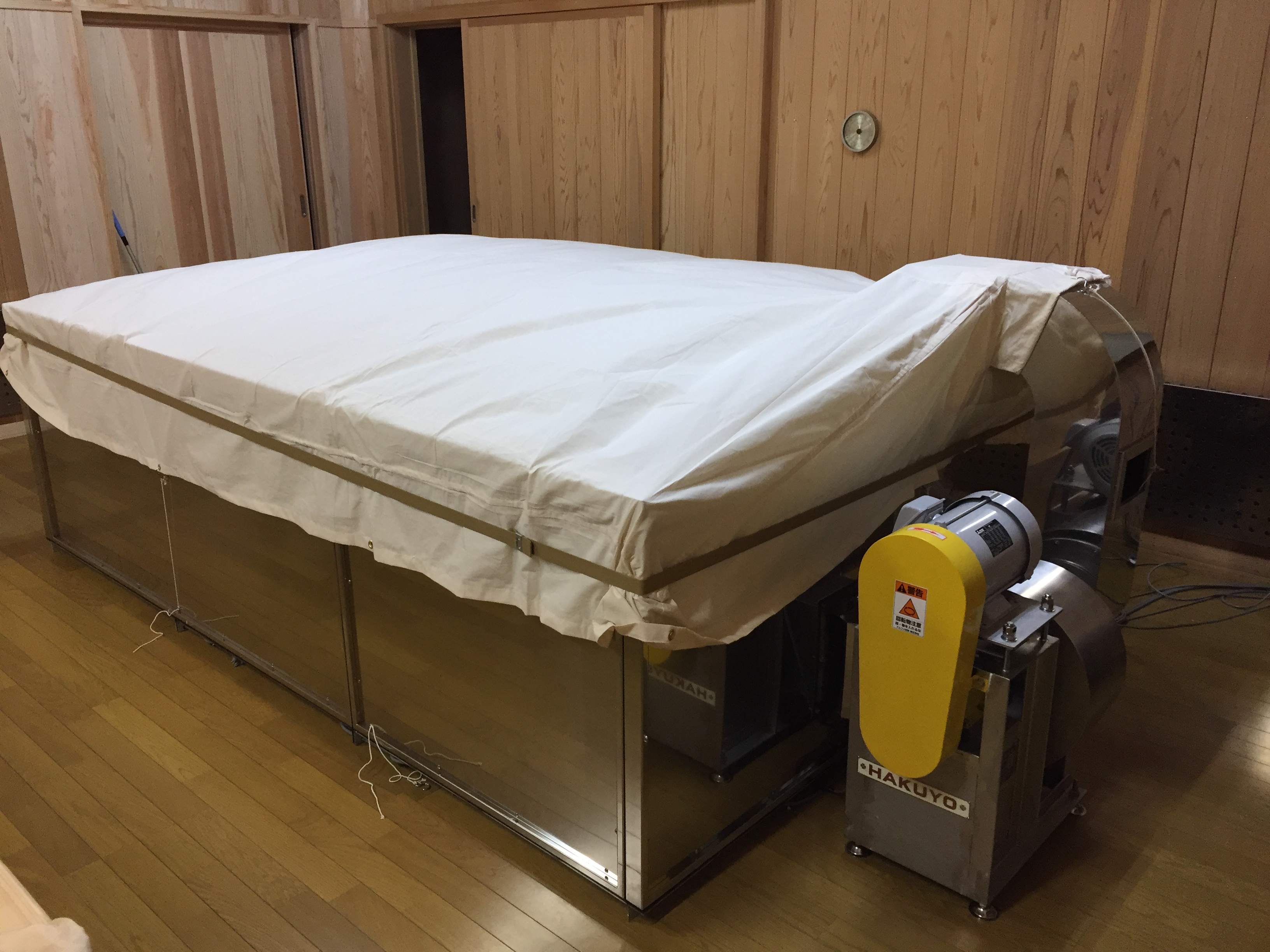 An example of a static flat bed: tent-type fermenter in a koji room - from hakuyoo.com
An example of a static flat bed: tent-type fermenter in a koji room - from hakuyoo.com
By blowing air through a bed of koji, a manufacturer can provide more oxygen and regulate heat transfer through a thicker mass of koji, making better use of floor space. Smaller fermenters are typically kept in climate-controlled rooms, so the blower only facilitates air movement. Larger configurations will have an air-handling unit attached to the blower, which facilitates temperature and humidity control. Some units are also equipped with a track-mounted mixer, which runs through horizontally through the bed of koji.
The static flat bed type is an all-encompassing term of various medium-scale koji fermenters, including tent-type, ventilated box-type, and “Castan”-type.
Multistage conveyor type
Capacity: 1000kg - 3000kg
Ventilation method: interior (stage 1), surface (stage 2)
Koji bed depth: 15cm (stage 1) 3 - 6cm (stage 2)
Application: Sake, especially Ginjo/Daiginjo
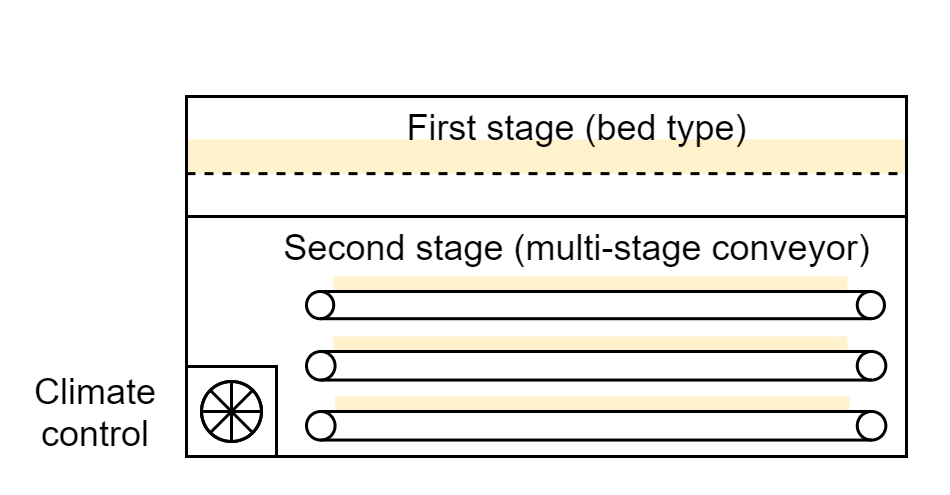 Multi-stage conveyor type process diagram
Multi-stage conveyor type process diagram
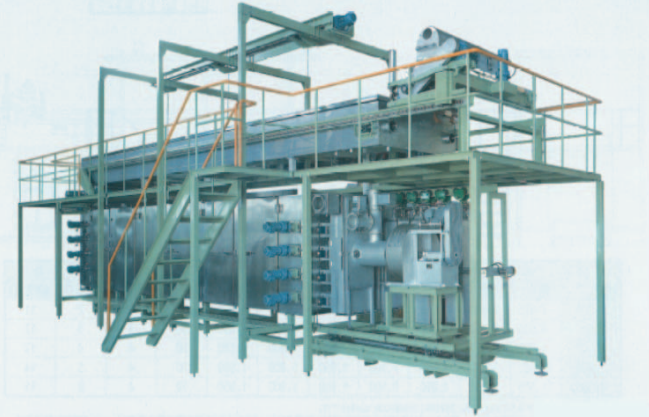 Exterior of multi-stage conveyor system - from www.masudasyoji.jp
Exterior of multi-stage conveyor system - from www.masudasyoji.jp
The multi-stage conveyor takes advantage of the koji’s different growth stages. In the first stage, the koji does not require much oxygen and also does not emit much heat. This means that it can be incubated in a thick static bed for the first 24h. Once the koji metabolism kicks into overdrive, it is spread thinly on a conveyor system for the latter 24h. They conveyor operates intermittently to mix and redistribute the koji itself.
I could only find one equipment manufacturer making this equipment configuration, so it seems to be rare.
Vapour exchange non-ventilated type
Capacity: 100 - 500kg
Ventilation: non-ventilated
Koji bed depth: 3 - 6cm
Application: Sake, especially Ginjo/Daiginjo
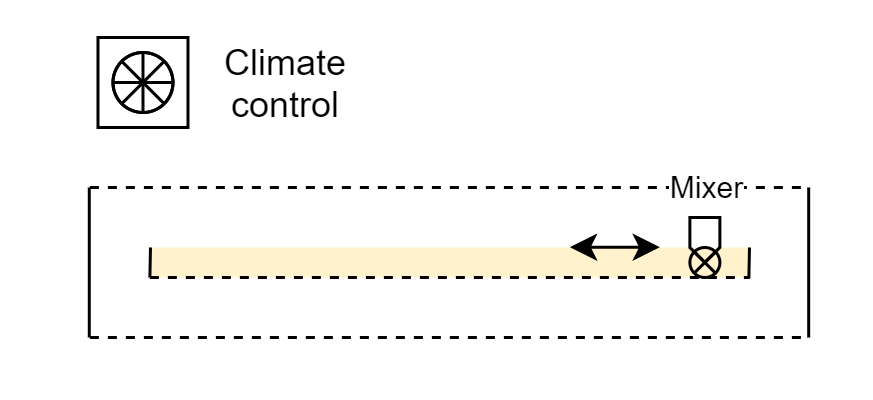 Unventilated-type process diagram
Unventilated-type process diagram
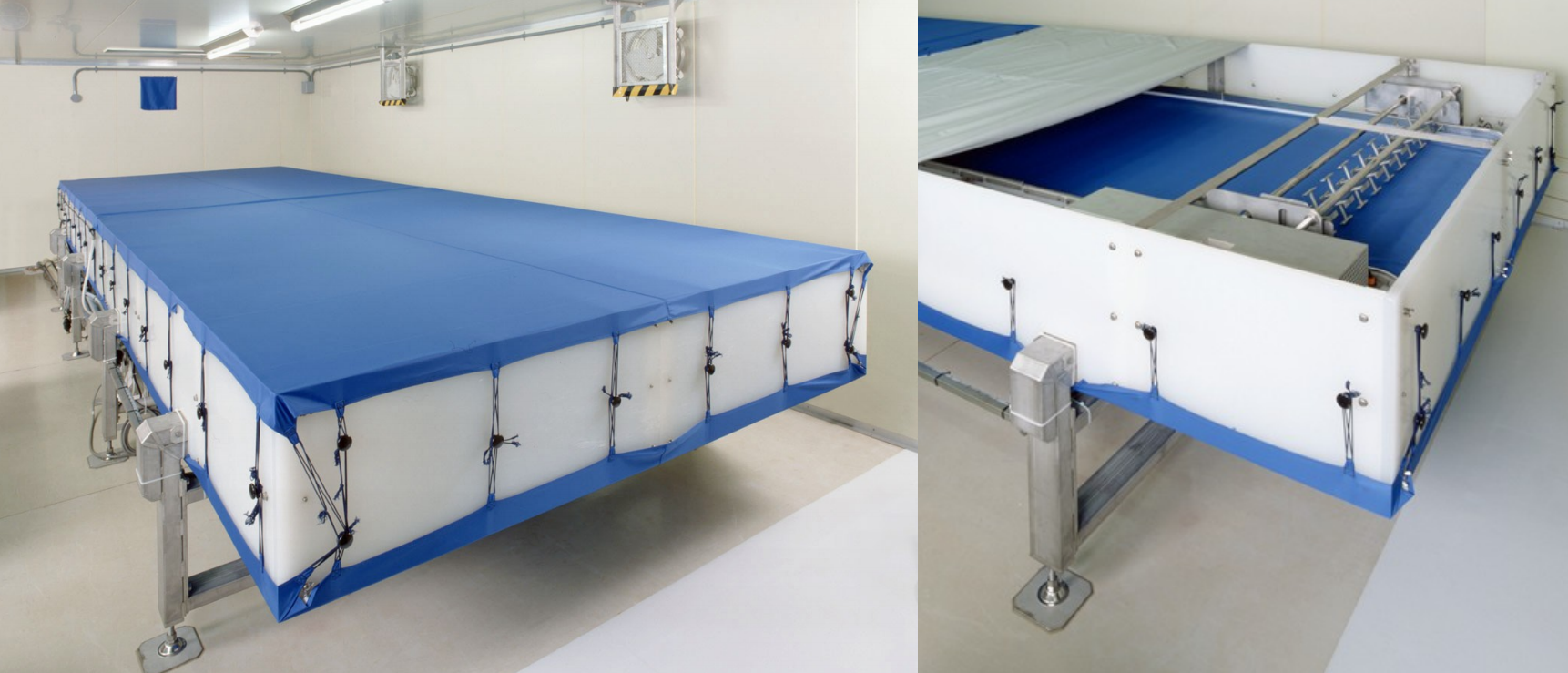 Unventilated-type closed (left) and with fabric opened (right) - from Fujiwara Techno-Art
Unventilated-type closed (left) and with fabric opened (right) - from Fujiwara Techno-Art
In these unventilated type machines, the koji sits in a thin layer on a plastic sheet. Two large sheets of plastic fabric are stretched above and below the koji bed. These sheets prevent dust and pathogens from getting onto the koji, but they are still permeable to air and moisture. As the koji heats up, a natural draft forms which allows air to flow through the koji bed. Direct removal of the plastic mesh fabric makes this device easy to clean.
Drum type
Capacity: 500 - 3000kg
Ventilation: interior
Koji bed depth: N/A
Application: Miso
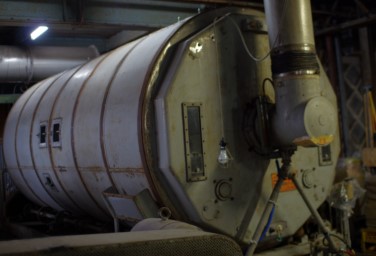
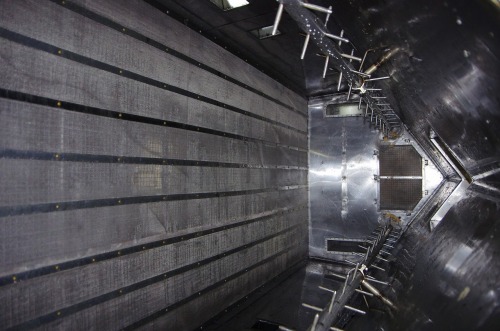 Drum-type fermenter exterior (top) and interior (bottom) - from iichimiso.com
Drum-type fermenter exterior (top) and interior (bottom) - from iichimiso.com
In drum-type fermenters, the koji sits on a mesh mounted approximately halfway between the edge of the drum and its centre axis. This mesh forms the bottom of a pentagonal housing that sits within the drum itself. Within this housing, two static mixers (metal rods with protrusions) extend along the axis of the drum. The drum is normally stationary, and is programmed to turn every so often to facilitate mixing. As it turns, the koji tumbles around and hits these mixers, breaking it up. Drum-type fermenters always have their own air handling unit. One key advantage of this type of fermenter is that some designs allow you to steam and cool the rice within the drum - saving one additional piece of equipment. Nevertheless, this type seems to have fallen out of favour in recent years.
This type of fermenter is commonly referred to as a “Tomuzetto” - I have no idea where the etymology comes from. My guess is an portmonteau of “tumble” and “set”.
Rotary disc type
Capacity: 1000 - 50000kg
Ventilation method: interior
Koji bed depth: 15 - 60cm
Application: Shochu, Shoyu, Miso, Sake
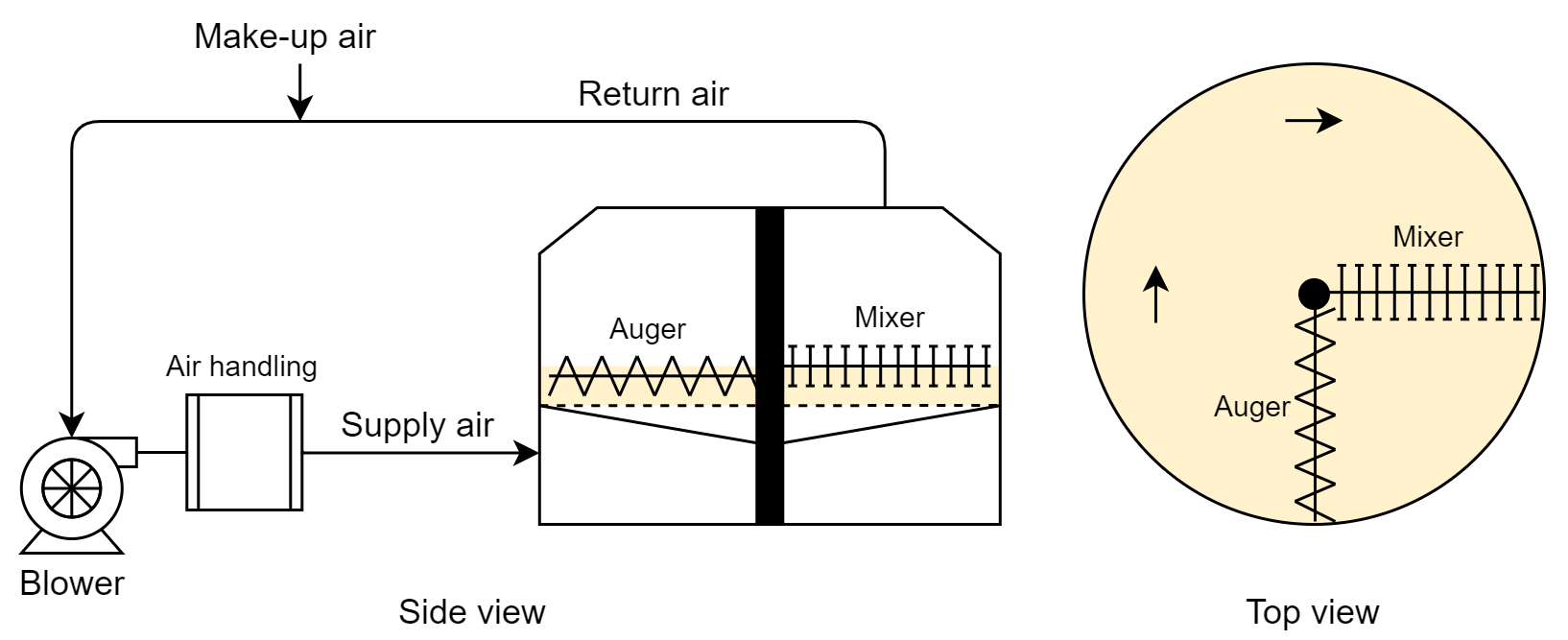 Rotary disc type process diagram
Rotary disc type process diagram
 Koji loading (left) with auger and mixing (right) - from www.hakutsuru.co.jp
Koji loading (left) with auger and mixing (right) - from www.hakutsuru.co.jp
In rotary disc type fermenters, the koji sits on a large, circular mesh disc that rotates along its vertical axis. An auger runs horizontally through the radius of the disc and facilitates loading and distribution of the koji into an even layer. A mixer also runs horizontally through the radius and breaks up the bed of koji as the disc rotates (at about ~0.3-0.5rpm). Note that rotary disc type fermenters always have their own air handling unit.
This fermenter scales incredibly well and dominates large scale facilities, such as those used by Marukome or Kikkoman.
Conclusion
I am glossing over three important topics here:
- Air handling units and process control
- Blowers, motors, and mechanical drives
- Sanitation and clean-in-place systems
These are lengthy topics and I’ll address them in a different post.
It seems that drum-type and rotary-disc type fermenters, which are used at the largest scale, are typically reserved for shoyu, miso, and cheap sake. Quality sake commonly uses the static bed, multi-stage conveyor, or vapour exchange unventilated type. The exact reason is not clear, but I would hazard a guess that Sake koji is more sensitive to conditions are requires greater care, where as miso and shoyu simply need to produce as much enzyme mass as possible for secondary fermentation and aging.
Additional reading
Here are some great general information sites on the topic. Nada-ken has an english translation of all articles.
I also recommend Miso Production by William Shurtleff & Akiko Aoyagi. If you haven’t already encountered them, they are two of the most dedicated people when it comes to transferring Japanese fermentation technology to the west.
Glossary of Japanese terms
English literature on koji fermenters is sparse, at best. For those of you looking to conduct your own research, here is a glossary of relevant Japanese terms.
| English | Japanese | Romaji / Pronounciation |
|---|---|---|
| Koji room | 麹室 / 製麹室 | Kōji muro / sei-kiku-shitsu |
| Tray / lid koji method | 蓋麹法 | Futa-kōji-hō |
| Box koji method | 箱麹法 | Hako-kōji-hō |
| Table / bed koji method | 床麹法 | Toko-kōji-hō |
| Machine koji method | 機械製麹法 | Kikai-sei-kiku-hō |
| Interior ventilation type | 内部通風式 | Naibu-tsufu-shiki |
| Surface ventilation type | 表面通風式 | Hyomen-tsufu-shiki |
| Multi-stage thin layer ventilation type | 薄層多段通風方式 | Hakusō-tadan-tsufu-hoshiki |
| Unventilated type | 無通風式 | Mu-tsufu-shiki |
| Static bed type | 静置平床式 | Seichi hiratoko-shiki |
| Tent type | 天幕式 | Tenmaku-shiki |
| “Casten” type | カステン式 | Kasuten-shiki |
| Conveyor type | コンベア式 | Konbea-shiki |
| Drum type | ドラム式 | Doramu-shiki |
| “Tomuzetto” type | トムゼット式 | Tomuzetto-shiki |
| Rotary type | 回転式 | Kaiten-shiki |
| Rotary disc type | 回転円盤式 | Kaiten enban-shiki |
| Automatic koji making machine | 自動製麹機 | Jidō-sei-kiku-ki |
| Automatic koji making equipment | 自動製麹装置 | Jidō-sei-kiku-sōchi |
Updated June 8, 2021 with minor changes
References
-
Chisti, Yusuf. (2014). Fermentation (Industrial): Basic Considerations. 10.1016/B978-0-12-384730-0.00106-3.
-
Yoshiya Fujiwara, Progress of Koji Making Equipment, Journal of The Brewing Society of Japan, 1993, Volume 88, No. 4, p. 281-286, Published 2011/09/20, Online ISSN 2186-4012, Print ISSN 0914-7314, https: //doi.org/10.6013/jbrewsocjapan1988.88.281
 Keith Wong
Keith Wong 
